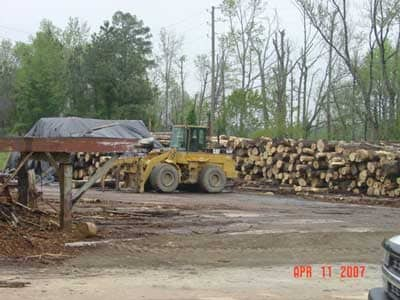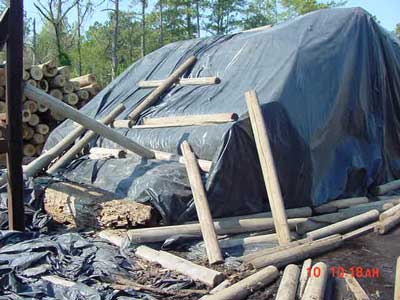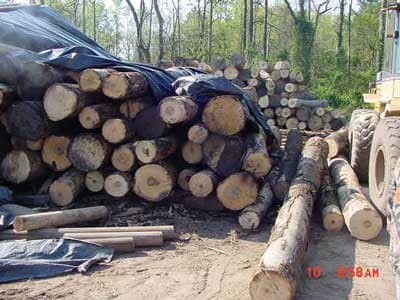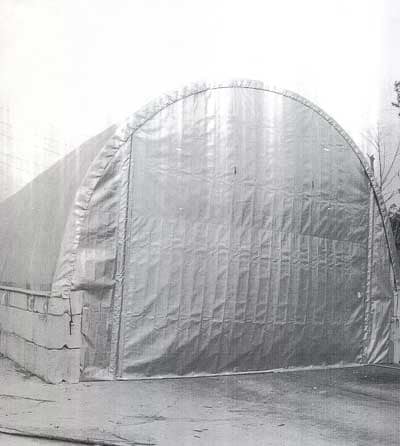Hispanic Yard Worker Dies After Being Pinned by a Release of Logs From a Log Stack – North Carolina
NIOSH In-house FACE Report 2007-05
July 29,2009
Summary
On April 10, 2007, a 20-year-old Hispanic yard worker (the victim) was killed when he was pinned by a release of logs from a log stack. The victim climbed up on the log stack approximately 14 feet in height and was removing a plastic tarp covering when the logs released and rolled out of the stack. The unconscious victim was pinned from the waist down by a stack of logs. A saw operator found the victim lying in the log stack within approximately 15 minutes. The operator ran inside to the production “main” building to get assistance. The victim’s father and some other workers ran outside to help. At the log stack a laborer yelled and told a maintenance worker to call 911 and to get a chain saw. The owner and some of the workers attempted to free the victim by cutting some of the logs. During this time, the victim was not breathing and he was unresponsive.
 |
|
Incident Scene. |
Approximately 4 minutes later, Emergency Medical Services (EMS) and the county sheriff arrived on the scene and the victim was still pinned in the log stack. EMS took over the scene and provided directions for the removal of the remaining logs. EMS determined that the victim was not breathing and had no carotid pulse. A medical examiner arrived on the scene and pronounced the victim dead, and he was transported to the morgue. Key contributing factors identified in this investigation include failure to eliminate the need to climb on stacked logs and not having logs properly stacked and secured.
NIOSH investigators concluded that, to help prevent similar occurrences, employers should:
- Eliminate the hazards associated with the need to climb on stacked logs to apply or remove tarp coverings through an engineering control measure (i.e., using a permanent tarp cover on a fixed frame)
- Ensure that logs are properly stacked, secured and maintained in a manner that minimizes worker exposure to injury from logs falling or rolling from the stack
- Develop, implement, and enforce a comprehensive occupational safety and health program and provide worker training that includes hazard recognition and the avoidance of unsafe conditions
Introduction
On April 10, 2007, a 20-year-old Hispanic yard worker (the victim) was killed when he was pinned by a release of stacked logs. On April 17, 2007, officials of the North Carolina Occupational Safety and Health Administration (NCOSHA) notified the National Institute for Occupational Safety and Health (NIOSH), Division of Safety Research (DSR), of the incident. On August 28, 2007, a DSR safety and occupational health specialist conducted an investigation of the incident and reviewed the incident circumstances with the NCOSHA investigating safety compliance officer assigned to the case. Photographs of the incident site and witness statements taken by NCOSHA shortly after the incident were reviewed. The sheriff’s report, medical examiner’s report and the death certificate were reviewed. On August 28, 2007, the Vice President/Operations Manager for the victim’s employer was interviewed at the worksite and the company safety program was reviewed.
Employer
The victim’s employer manufactures wood veneers and had been in business for 40 years. The business is managed by a third generation family member. The company employs 50 full-time workers in the state of North Carolina. The workers work 10 hours each day, five days a week. Approximately 35 percent of the workers are Hispanic. This was the company’s first workplace fatality.
Victim
The 20-year-old male Hispanic (the victim) had been working full-time for the company as a yard worker for approximately 4 years. According to the Vice President/Operations Manager of the company, the victim was fluent in English.
During his employment, the victim was assigned to work on the yard crew. A yard worker’s duties consist of receiving, sorting, and organizing incoming logs. All of the logs are received by tractor trailer. A yard worker unloads the logs with a front end loader and then stacks them for storage until they are sorted by species. Once the logs are sorted by species, they are again stacked using a front end loader and are covered with a plastic tarp in the log steaming area. The logs are steamed for twenty-four hours. After the wood is steamed and softened, a yard worker loads it onto a front end loader and delivers it to the dock area, where lathes peel the logs into veneer. The veneer is then dried in a kiln to a specified moisture content and is packaged and sold commercially to local and national vendors. The victim was wearing a uniform, a jacket and work boots.
Written Safety Program and Training
The company had a generic written safety program. According to NCOSHA, the employer’s insurance company had previously provided them with basic safety and health programs that the employer could tailor specifically to their operations. Additionally, NCOSHA stated that the employer had a NCOSHA inspection in 2001 and was provided with sample programs and policies that could be personalized. The Vice President/Operations Manager of the company provides the majority of the safety training, but some times uses the assistance of a worker to do training. According to NCOSHA, when the victim was hired, the Vice President/Operations Manager provided some verbal instructions on how to apply and uncover the logs with a plastic tarp. During the NCOSHA interviews, a yard worker said that other yard workers had provided him with instruction on how to ascend and apply the tarps and uncover the logs.
Incident Scene
The work site is located on 30 acres and has the following areas, log storage, 2 log steaming stacks, production building, boiler rooms, and a warehouse building. There are two log steaming stacks located within the yard area. The incident occurred at one of the log steaming stacks that had completed the steaming process. It contained approximately 120 gum tree logs that had diameters ranging from 13 to 26 inches and were approximately 17 feet in length. There were two parallel pieces of wood called “log runners” that ran the length of the stack to keep the logs off the ground over the steam vent. Each stack had a rear metal brace (approximately 10 feet in height and 10 feet in width) against which the logs could be stacked to prevent them from rolling. Following this incident, NCOSHA inspected both of the log steaming stacks and both revealed that these logs had not been positioned against the braces (Photo 1). The log stack where the incident occurred ranged 12 to14 feet in height.
Weather
It was daylight at the time of incident and the temperature was in the 30’s
Investigation
On April 10, 2007, at approximately 7:00 a.m. a Hispanic yard worker (the victim) started work in the yard area of a wood veneer worksite. In the yard area, he drove a front end loader to a log stack that had completed a 24-hour steaming process. The victim parked the front end loader approximately 7 feet from the log runners that kept the stacked logs off the ground. In order to remove the plastic tarp covering the log stack, the victim removed various pieces of wood lying on the tarp that were used to secure it. He then climbed approximately 14 feet, to remove the tarp. According to NCOSHA, it appears that the victim started removing the plastic tarp on the right front side and he was progressing towards the rear section of the log stack. The logs shifted and rolled down and pinned the victim (Photo 2).
Within approximately 15 minutes a saw operator returning to the dock area noticed that one of the log steaming stacks was partially uncovered, while the other log stack was fully covered. The operator went to check the deck area and saw that no logs had been loaded, so he walked over to the partially uncovered logs. The operator found the victim; he was unconscious and pinned from the waist down in the logs. The operator ran to the production building to get help. The owner, the victim’s father and some of the workers ran out to the log stack. At the stack, a laborer yelled and told a maintenance worker to call 911 and to get a chain saw. The owner and some of the workers attempted to free the victim by cutting some of the logs. During this time, the victim was unresponsive and he was not breathing.
At approximately 7:15 a.m., Emergency Medical Services (EMS) and the county sheriff were dispatched to the incident scene. At approximately 7:19 a.m., EMS and the sheriff arrived at the scene and found the victim lying pinned in the log stack. EMS provided directions for the removal of the remaining logs. At approximately 7:23 a.m., EMS determined that the victim was not breathing and had no carotid pulse. At approximately 7:25 a.m., EMS requested that the medical examiner respond to the incident scene. At approximately 7:55 a.m., the medical examiner arrived and pronounced the victim dead. At approximately 8:40 a.m., the victim was transported to the morgue.
Contributing Factors
Occupational injuries and fatalities are often the result of one or more contributing factors or key events in a larger sequence of events that ultimately result in the injury or fatality. NIOSH investigators identified the following items as key contributing factors in this incident that ultimately led to the fatality:
- The failure to eliminate the need to climb on stacked logs.
- Not having logs secured and properly stacked.
Back to Top
Cause of Death
The medical examiner’s report stated that the cause of death was a crush injury to the trunk.
Recommendations/Discussion
Recommendation #1: Employers should eliminate the hazards associated with the need to climb on stacked logs to apply or remove tarp coverings through an engineering control measure (i.e., using a permanent tarp cover on a fixed frame).
D iscussion: Controlling exposures to occupational hazards is the fundamental method of protecting workers. Traditionally, a hierarchy of controls has been used as a means of determining how to implement feasible and effective controls. One representation of this hierarchy can be summarized as follows: 1
- Elimination
- Substitution
- Engineering controls
- Administrative controls
- Personal protective equipment
The idea behind this hierarchy is that the control methods at the top of the list are potentially more effective and protective than those at the bottom. Following the hierarchy normally leads to the implementation of inherently safer systems, ones where the risk of illness or injury has been substantially reduced.1 Engineering controls are used to remove a hazard or place a barrier between the worker and the hazard. Well-designed engineering controls can be highly effective in protecting workers and will typically be independent of worker actions. The initial cost of engineering controls can be higher than the cost of administrative controls or personal protective equipment, but over the longer term, operating costs are frequently lower, and in some instances, can provide a cost savings in other areas of the process.1
In this incident, a characteristic of the worksite that produced a significant hazard to the yard workers were the logs that were stacked prior to being steamed. This process required that workers climb to a height of approximately 14 feet high on a log stack in order to apply a tarp, and then 24 hours later, a worker would ascend the stack again to remove the tarp from the steamed logs. Such a hazard at the worksite could be eliminated by applying an engineering control measure, like using a permanent tarp cover on a fixed frame, which would remove the necessity for a yard worker to climb onto the stack and remove a plastic tarp. Following this incident, the employer built a permanent concrete foundation with a permanent tarp cover on a fixed frame over each of the log steaming stacks, which eliminates the need for workers to climb in order to apply or uncover a plastic tarp (Photo 3).
Additionally, to assist with controlling exposures to occupational hazards at a work site, an employer could develop and utilize a safety checklist as part of a standard operating procedure. This should be done at the work site initially and when any activities or job changes are made.
Recommendation #2: Employers should ensure that logs are properly stacked, secured and maintained in a manner that minimizes worker exposure to injury from logs falling or rolling from the stack.
Discussion: “Logs will always present a hazard, even at ground level, a rolling log can cause injury to workers in the vicinity. The greater hazards results from logs at height from the ground and their potential to cause serious injury and even death.” 2 When employers are storing logs in stacks at a worksite, a myriad of concerns that impact the workers safety need to be properly addressed. The risks associated with log stacks can be minimized by recognizing some of the safety hazards (i.e., height, length, diameter variations, ground conditions and stack angle) which increase the risk of them becoming unstable, and understanding how these risks can be reduced.2 The Occupational Safety and Health Administration (OSHA) has regulations regarding the importance of providing and maintaining secure storage on a worksite. According to OSHA 1910.176(b), regarding the need for secure storage, “the storage of material shall not create a hazard. Bags, containers, bundles, etc., stored in tiers shall be stacked, blocked, interlocked and limited in height so that they are stable and secure against sliding or collapse.” 3
According to NCOSHA, the log stack where the incident occurred was not blocked, interlocked or limited in height so that it was stable and secure against sliding and collapse. Since the logs in a stack are accessed and removed while using a front loader, the need for the logs to be properly braced and cribbed in order to prevent the logs from shifting forward is paramount. The logs need to be reached safely by workers and the equipment that is being used. According to the Vice President/Operations Manager, at the time of the incident the log stack consisted of approximately 120 gum tree logs that were approximately 17 feet in length and ranged in diameters of 13 to 26 inches. In addition, due to the time of season when this incident occurred, the logs being steamed were a very slippery texture, due to the rise in sap that had occurred in the gum trees.
Employers that store logs in stacks need to ensure that they are properly stacked and maintained to minimize worker exposure to unsafe conditions. An inspection by the NCOSHA of both of the steamed log stacks revealed that the logs had not been stacked against a metal brace on the rear section of each stack, which may have helped prevent the unsecured logs from shifting. Additionally, according to NCOSHA, neither of the steamed log stacks had any type of cribbing or brace to prevent the logs from shifting forward. NCOSHA estimated that the stacked logs, where the victim was pinned, had rolled down approximately five feet during the incident.
Recommendation #3: Employers should develop, implement, and enforce a comprehensive occupational safety and health program and provide worker training that includes hazard recognition and the avoidance of unsafe conditions.
Discussion: Employers should evaluate all tasks performed by workers, identify all potential hazards, and then develop, implement, and enforce a written safety and health program that meets applicable OSHA standards and addresses these hazards. A comprehensive written occupational safety and health program must be developed for all workers and include training in hazard recognition and the avoidance of unsafe conditions. The safety and health program should include, at a minimum, an explanation on the worker rights to protection in the workplace, safe work practices workers are expected to adhere to, specific safety protection for all tasks performed, ways to identify and avoid hazards, and who they should contact when safety and health issues or questions arise. It should then be noted in a company’s safety and health program that certain types of site-specific training (i.e., working around logs and using mobile equipment) must be conducted and documented.
Employers should conduct a worksite hazard survey to identify the potential hazards that workers are exposed to4 so that appropriate preventive measures for these hazards can be identified and an engineering control measure can be implemented. Examples of hazards at this worksite included the potential for rolling logs and falls from height associated with climbing on stacked logs to apply or remove tarp coverings and the hazards associated with operating front end loaders. A worksite hazard survey could identify hazards with climbing on logs, which would lead to a safer approach like what the employer implemented through an engineering control measure. Hazard recognition training should be based on an evaluation of the tasks workers will perform for all potential hazards. These identified hazards and their controls should be incorporated into hazard recognition training. The training should also include specific instructions that workers should not risk physical harm to accomplish tasks. OSHA regulations require employers to train workers to recognize and avoid unsafe conditions that may be present in their work environments, and to provide training on the regulations applicable to their work.
The employer needs to train each employee in the recognition and avoidance of unsafe conditions and the regulations applicable to their work environment to control or eliminate any hazards or other exposure to injury or illness. When the victim was hired, he did not receive any type of formal training. He was provided verbal instructions on how to climb, apply and uncover logs with a tarp. During the NCOSHA interviews, a yard worker conveyed that other yard workers provided him with instructions on how to work with steamed logs. Working as a yard worker exposes a worker to multiple and complex hazards. It cannot be assumed that employees can recognize the hazards of climbing on log stacks and logs rolling and falling. Training in recognizing and avoiding hazards should be given to all workers, coupled with employer assessments that workers are competent in the recognition of hazards and safe work practices. Some minimum components for employers to consider when they are providing safety training to workers are the following: 1) general recognition, 2) safe performance of assigned tasks, and 3) safe use and maintenance of tools or equipment. The training program content and the names and dates of employees completing the training should be documented and retained by the employer. Employers should also ensure that the trainer who provides training is qualified through education and/or experience to conduct training. To ensure the utility of the safety training, an employer might consider ways to ensure that the worker comprehends the important information (e.g., written testing, verbal questions, or role playing).
References
- NIOSH [2008]. NIOSH Safety and Health Topic Page: Engineering Controls: [https://www.cdc.gov/niosh/topics/engcontrols/]. Date accessed: May 21, 2009.
- Health and Safety Executive [1999]. Stability of stacked logs: pdf iconexternal icon[http://www.hse.gov.uk/fod/stacklog.pdf]. Date accessed: May 21, 2009.
- Code of Federal Regulations [2005]. 29 CFR 1910.176(b). Materials Handling and Storage. Washington, D.C.: U.S. Printing Office, Office of the Federal Register.
- National Safety Council [1997]. Accident Prevention Manual For Business & Industry. Identifying Hazards, Itasca, IL.
Investigator Information
This investigation was conducted by Nancy T. Romano, Safety and Occupational Health Specialist, Fatality Investigations Team, Surveillance and Field Investigations Branch, Division of Safety Research.
Acknowledgement
The NIOSH FACE Program and the safety and occupational health specialist would like to acknowledge the Compliance Officer and staff of the North Carolina Occupational Safety and Health Division (NCOSHA) program for providing information for this investigation.
Photos

|

|

|
|
Photo 3. A Permanent Tarp Cover on a Fixed Frame Covering a Steamed Log Stack. |
|
Fatality Assessment and Control Evaluation (FACE) Program The National Institute for Occupational Safety and Health (NIOSH), an institute within the Centers for Disease Control and Prevention (CDC), is the federal agency responsible for conducting research and making recommendations for the prevention of work-related injury and illness. In 1982, NIOSH initiated the Fatality Assessment and Control Evaluation (FACE) Program. FACE examines the circumstances of targeted causes of traumatic occupational fatalities so that safety professionals, researchers, employers, trainers, and workers can learn from these incidents. The primary goal of these investigations is for NIOSH to make recommendations to prevent similar occurrences. These NIOSH investigations are intended to reduce or prevent occupational deaths and are completely separate from the rulemaking, enforcement and inspection activities of any other federal or state agency. Under the FACE program, NIOSH investigators interview persons with knowledge of the incident and review available records to develop a description of the conditions and circumstances leading to the deaths in order to provide a context for the agency’s recommendations. The NIOSH summary of these conditions and circumstances in its reports is not intended as a legal statement of facts. This summary, as well as the conclusions and recommendations made by NIOSH, should not be used for the purpose of litigation or the adjudication of any claim. For further information, visit the program website at www.cdc.gov/niosh/face/ or call toll free at 1-800-CDC-INFO (1-800-232-4643). |
